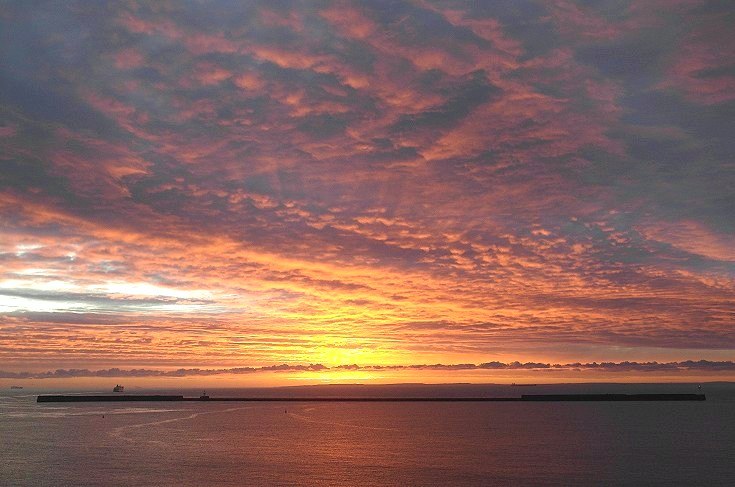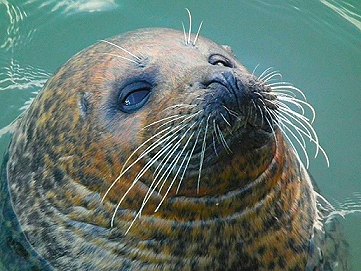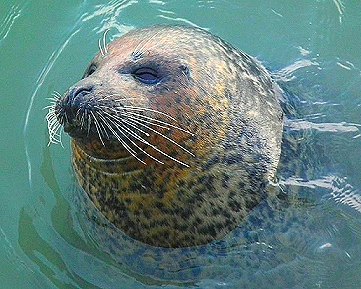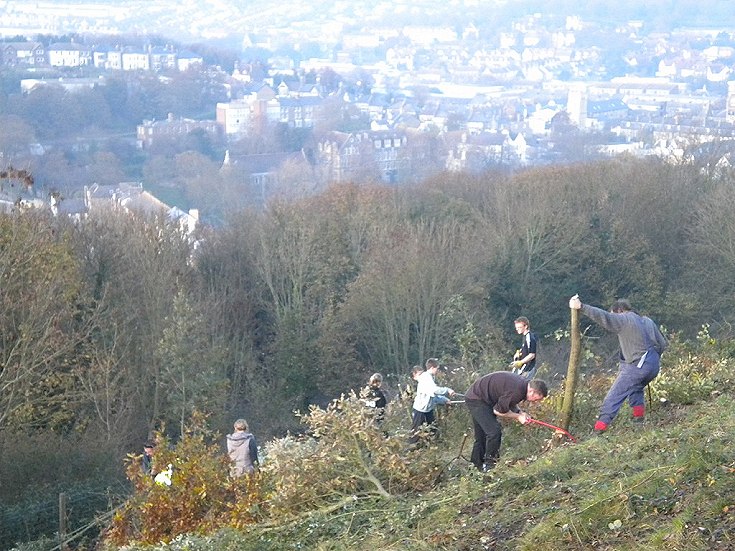The Front Page. - Copy 220 (Seals Revisit, Sunrise Dover Straits, Nature Clean-ups)
18 December 2011

The Dover Straits: For a very brief magical spell on monday morning there was an amazing sky. In the time it took to load this picture on Doverforum, the whole vista had veered away from the dramatic colour as shown in the picture above and returned sadly to slate grey, or almost. Ah...The English Channel...the stuff of legend, never the same two days running. We shuffle from tempest to tranquility and in the briefest of times. Today all is tranquil on the Dover Straits. PB
(Ps: Hit the f11 key to see the full sweep of pictures.)

 The stunning seal pictures above were taken on sunday from the Prince of Wales pier by our regular ace Paul Scotchie Wells and show what looks to me..non natural expert that I am... like the common seal. If anyone has any further info please let us know. But he is a delightful visitor just in time for this season of goodwill. (Perhaps he wants to try out our local Christmas shopping!)
The stunning seal pictures above were taken on sunday from the Prince of Wales pier by our regular ace Paul Scotchie Wells and show what looks to me..non natural expert that I am... like the common seal. If anyone has any further info please let us know. But he is a delightful visitor just in time for this season of goodwill. (Perhaps he wants to try out our local Christmas shopping!)
Forumite Tom Austin has added the following info to the thread in the forum...
Common Seals:Common seals, sometimes called ‘harbour seals’, are widely distributed across the northern parts of the Atlantic and Pacific oceans. Coat colour and pattern vary considerably between different regions. Common seals around Scotland have attractive coats, mottled with spots and rings, and can be anything between dark brown to pale grey-white. Their backs are often darker than their stomachs and chests. Males average about 1.5 metres (4.9 feet) in length, while females are slightly smaller, and average 1.4 metres (4.6 feet). Their scientific name – Phoca vitulina – means ‘seal calf’. There are five races of common seal and the UK supports 40 per cent of the European race Phoca vitulina vitulina – equivalent of 5 per cent of the world population.
http://www.doverforum.com/letters/viewtopic.php?id=9039 See this thread for more...
also see our thread on Christmas Shopping in Dover..is it any good?? Let us know what you think..dover7@msn.com.
http://www.doverforum.com/letters/viewtopic.php?id=9004
PaulB
* *
We're running a tad late with the following item, held up due to backlog but delighted to include it now. Shows the great work of the volunteers again. There is still time to take part and join in...see the body copy below, the next clean up is on December 29 if you want to take part.

On Sunday 20th November, between 20 and 30 volunteers from both White Cliffs Countryside Partnership(WCCP) and the Western Heights Preservation Society (WHPS) met up to work on the historic slopes of the Drop Redoubt field led by WCCP's Melanie Wrigley, to remove invasive scrub, bambles and trees that are growing into the slopes/structure of the hillfort.
It was a bright, sunny winters day and unseasonally warm. The view's of Dover and the castle from the Heights were really stunning with the beautiful autumnal colours and bright blue sky. And all the volunteers worked so hard together to cut and clear the scrub. It was a really jovial day with all the people mixing and having a chat with each other. Mel Wrigley would like to say thank you to everybody who kindly came out to help on that volunteer task day.
All the volunteers worked hard, cutting and clearing the scrub and trees with hand tools alone. The area that we were clearing once had a colony of Bee orchids, common spotted and pyramidal orchids growing in the chalk turf. Lack of enough grazing (due to old, unsecure fencing) has enabled the scrub to grow which has shaded out the chalk grassland species and the associated wildlife. With the new fencing, more grazing animals and this scrub clearing we hope that we can restore this particular area
of chalk grassland and we will see some of these species back in this area again.
Historically, the military grazed the surrounding slopes of the Western Heights fortress to keep it as open chalk grassland, as they wanted to prevent the enemy from having somewhere to hide in the event of invasion. Looking back at aerial photos of Dover, all the hillsides around Dover were open, chalk grassland without trees and bushes becuase they have been grazed for hundreds and probably thousands of years. It's only really since the 1960's, when myxamatosis killed so many rabbits, and changes in agricultural economics led to fewer grazing animals around, that the scrub and bushes have grown up on the hillsides. Aerial photos taken in 1961,show Dover's hills like the Western Heights and Whinless Down were open grassland with trees or scrub almost completely absent.
Our next WCCP scrub and site maintenance on the Western Heights will be on Thursday 29th December at St Martins Battery Field. Meet at St Martins Battery Car Park, South Military Hill at 10.15. Call Paul Sampson for more details on 07773 619121.
Thank you to all who participate in the WCCP volunteer tasks - we couldn't do so much for the local wildlife and landscape without your continued help.
Melanie Wrigley
Assistant Project Manager
WCCP.
Paul Sampson
Partnership Officer.
White Cliffs Countryside Partnership.
Dover District Council.
White Cliffs Business Park.
Dover.
CT16 3PJ.
Picture of clean-up by Paul Sampson.
* *
Previous features can now be found in All Recent Features...see menu left.

The Dover Straits: For a very brief magical spell on monday morning there was an amazing sky. In the time it took to load this picture on Doverforum, the whole vista had veered away from the dramatic colour as shown in the picture above and returned sadly to slate grey, or almost. Ah...The English Channel...the stuff of legend, never the same two days running. We shuffle from tempest to tranquility and in the briefest of times. Today all is tranquil on the Dover Straits. PB
(Ps: Hit the f11 key to see the full sweep of pictures.)
Christmas Visitor...coming to see the sights of Dover.


Forumite Tom Austin has added the following info to the thread in the forum...
Common Seals:Common seals, sometimes called ‘harbour seals’, are widely distributed across the northern parts of the Atlantic and Pacific oceans. Coat colour and pattern vary considerably between different regions. Common seals around Scotland have attractive coats, mottled with spots and rings, and can be anything between dark brown to pale grey-white. Their backs are often darker than their stomachs and chests. Males average about 1.5 metres (4.9 feet) in length, while females are slightly smaller, and average 1.4 metres (4.6 feet). Their scientific name – Phoca vitulina – means ‘seal calf’. There are five races of common seal and the UK supports 40 per cent of the European race Phoca vitulina vitulina – equivalent of 5 per cent of the world population.
http://www.doverforum.com/letters/viewtopic.php?id=9039 See this thread for more...
also see our thread on Christmas Shopping in Dover..is it any good?? Let us know what you think..dover7@msn.com.
http://www.doverforum.com/letters/viewtopic.php?id=9004
PaulB
* *
We're running a tad late with the following item, held up due to backlog but delighted to include it now. Shows the great work of the volunteers again. There is still time to take part and join in...see the body copy below, the next clean up is on December 29 if you want to take part.

On Sunday 20th November, between 20 and 30 volunteers from both White Cliffs Countryside Partnership(WCCP) and the Western Heights Preservation Society (WHPS) met up to work on the historic slopes of the Drop Redoubt field led by WCCP's Melanie Wrigley, to remove invasive scrub, bambles and trees that are growing into the slopes/structure of the hillfort.
It was a bright, sunny winters day and unseasonally warm. The view's of Dover and the castle from the Heights were really stunning with the beautiful autumnal colours and bright blue sky. And all the volunteers worked so hard together to cut and clear the scrub. It was a really jovial day with all the people mixing and having a chat with each other. Mel Wrigley would like to say thank you to everybody who kindly came out to help on that volunteer task day.
All the volunteers worked hard, cutting and clearing the scrub and trees with hand tools alone. The area that we were clearing once had a colony of Bee orchids, common spotted and pyramidal orchids growing in the chalk turf. Lack of enough grazing (due to old, unsecure fencing) has enabled the scrub to grow which has shaded out the chalk grassland species and the associated wildlife. With the new fencing, more grazing animals and this scrub clearing we hope that we can restore this particular area
of chalk grassland and we will see some of these species back in this area again.
Historically, the military grazed the surrounding slopes of the Western Heights fortress to keep it as open chalk grassland, as they wanted to prevent the enemy from having somewhere to hide in the event of invasion. Looking back at aerial photos of Dover, all the hillsides around Dover were open, chalk grassland without trees and bushes becuase they have been grazed for hundreds and probably thousands of years. It's only really since the 1960's, when myxamatosis killed so many rabbits, and changes in agricultural economics led to fewer grazing animals around, that the scrub and bushes have grown up on the hillsides. Aerial photos taken in 1961,show Dover's hills like the Western Heights and Whinless Down were open grassland with trees or scrub almost completely absent.
Our next WCCP scrub and site maintenance on the Western Heights will be on Thursday 29th December at St Martins Battery Field. Meet at St Martins Battery Car Park, South Military Hill at 10.15. Call Paul Sampson for more details on 07773 619121.
Thank you to all who participate in the WCCP volunteer tasks - we couldn't do so much for the local wildlife and landscape without your continued help.
Melanie Wrigley
Assistant Project Manager
WCCP.
Paul Sampson
Partnership Officer.
White Cliffs Countryside Partnership.
Dover District Council.
White Cliffs Business Park.
Dover.
CT16 3PJ.
Picture of clean-up by Paul Sampson.
* *
If you want to comment on any of our stories please do in our FORUM see links.
Previous features can now be found in All Recent Features...see menu left.